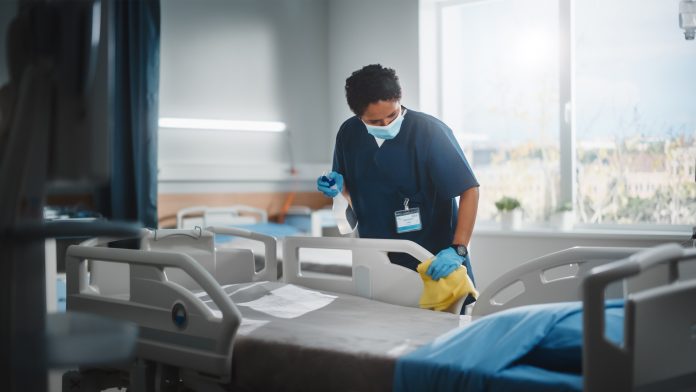
New data finds that adding aerosolised hydrogen peroxide to hospital infection prevention protocols can effectively reduce Clostridium difficile infection rates.
A clostridium difficile infection is a type of bacteria that can cause diarrhoea, a high temperature and a loss of appetite. It is one of the most common healthcare-associated infections (HAIs), amongst patients in large, acute-care facilities. The new study has discovered a new method to mitigate this growing problem through an aerosolised hydrogen peroxide disinfection system.
“Our study showed that persistence in utilising an aerosolised hydrogen peroxide system had a significant impact on reducing C. difficile infections hospital-wide,” said Christopher L. Truitt, PhD, Wayland Baptist University, and the paper’s lead author.
The study appears in the American Journal of Infection Control (AJIC).
Clostridium difficile infection
Clostridium difficile infections are responsible for 223,000 HAI’s leading to more than 12,000 deaths and $6.3 billion in costs in the United States annually, according to the Centers for Disease Control and Prevention and The Joint Commission.
Clostridium difficile spores are typically transmitted by environmental surfaces in hospital rooms, including bed handrails, equipment controls, and doorknobs, and are resistant to hand sanitisers and most disinfectants. This resistance poses a problem for healthcare environments and can cause mass spreading of the Clostridium difficile infection. This highlights the necessity of enhanced protocols for hand hygiene and environmental cleaning, along with improving antibiotic prescribing to prevent Clostridium difficile infection. However, even with heightened measures in place, the microbe is difficult to eradicate from hospital surfaces.
Aerosolised hydrogen peroxide system offers a touchless, whole-room approach to improve standard environmental cleaning protocols. The system generates aerosolised dry-mist fog that contains a specified percentage of hydrogen peroxide. The fog covers all exposed surfaces to kill any Clostridium difficile spores that remain following physical cleaning. To date, no long-term data are evaluating the use of these systems.
Studying the effectiveness of aerosolised hydrogen peroxide
To study the effectiveness of this system, Dr Truitt and his colleagues retrospectively analysed Clostridium difficile infection rates at a large, acute-care facility in Philadelphia, Pennsylvania, over ten years to evaluate the effectiveness of an aerosolised hydrogen peroxide disinfection system for reducing infection rates. The researchers compared the incidence of healthcare-associated Clostridium difficile infections at the facility before and following the implementation of the system as an addition to standard patient-room cleaning procedures following the discharge or transfer of patients with a clostridium difficile infection.
The teams’ findings suggest that consistently using the disinfection system, contributed to a significant and sustained reduction in Clostridium difficile infection rates. Throughout the 27 months before implementation of the system, the facility recorded 120 healthcare-associated clostridium difficile infections. Following the implementation, 72 cases were noted over a 33-month interval, reflecting a 41% decrease in infection rates.
Over an additional five-year period during which the aerosolised hydrogen peroxide system was consistently utilised along with an environmental cleaning program and other measures, including antibiotic stewardship, researchers observed a 74% reduction in hospital-onset CDI. *Between January 2015 and December 2019, CDI rates consistently decreased from 5.4 per 10,000 patient days to 1.4 per 10,000 patient days.
“CDI is difficult to prevent because it is so hard to eliminate from the environment. The study conducted by Dr Truitt and colleagues provides valuable insight about the benefits of supplementing prevention efforts with aHP to help meaningfully decrease rates of this often-deadly disease,” said Linda Dickey, RN, MPH, CIC, FAPIC, and 2022 APIC president.










